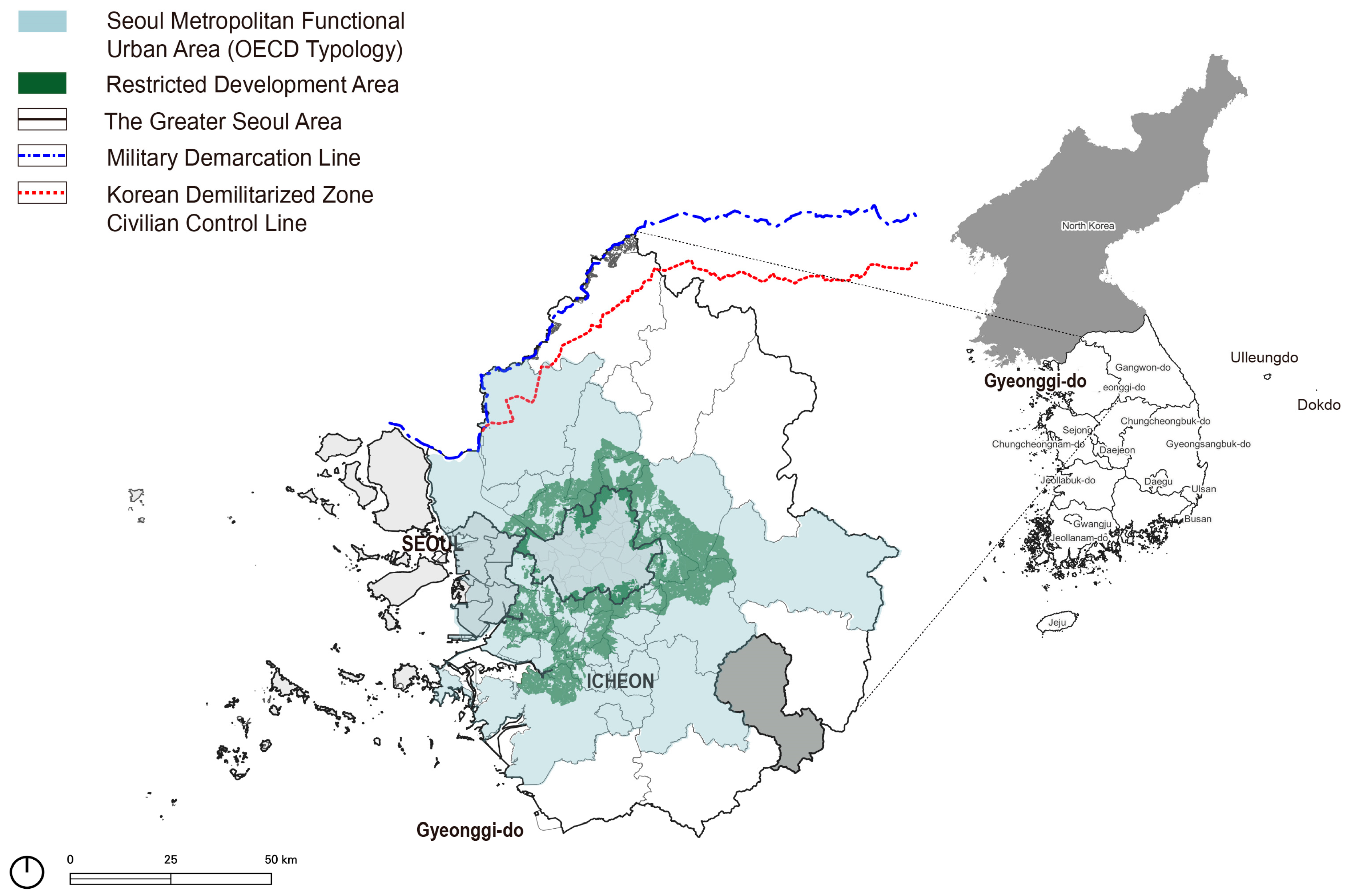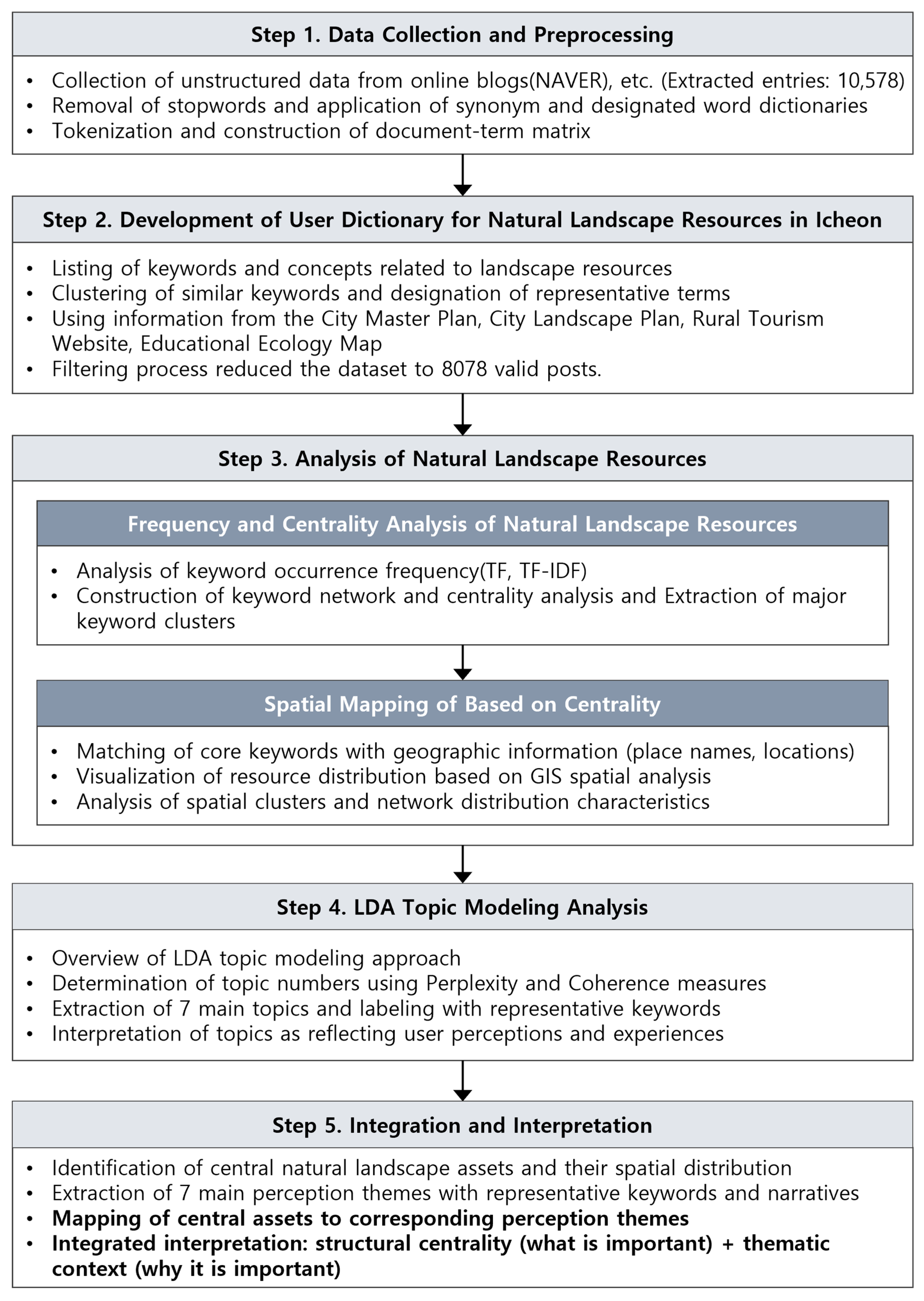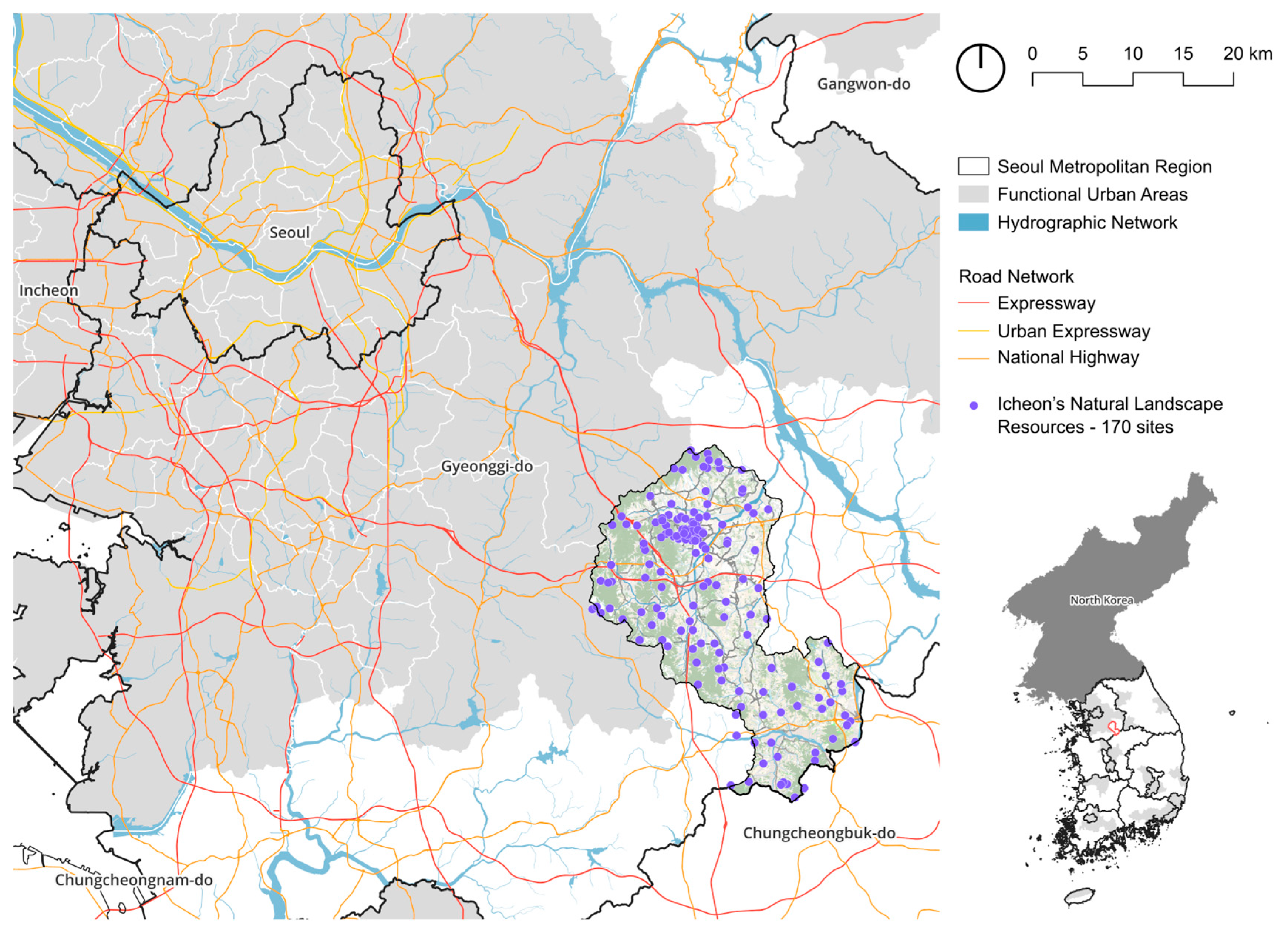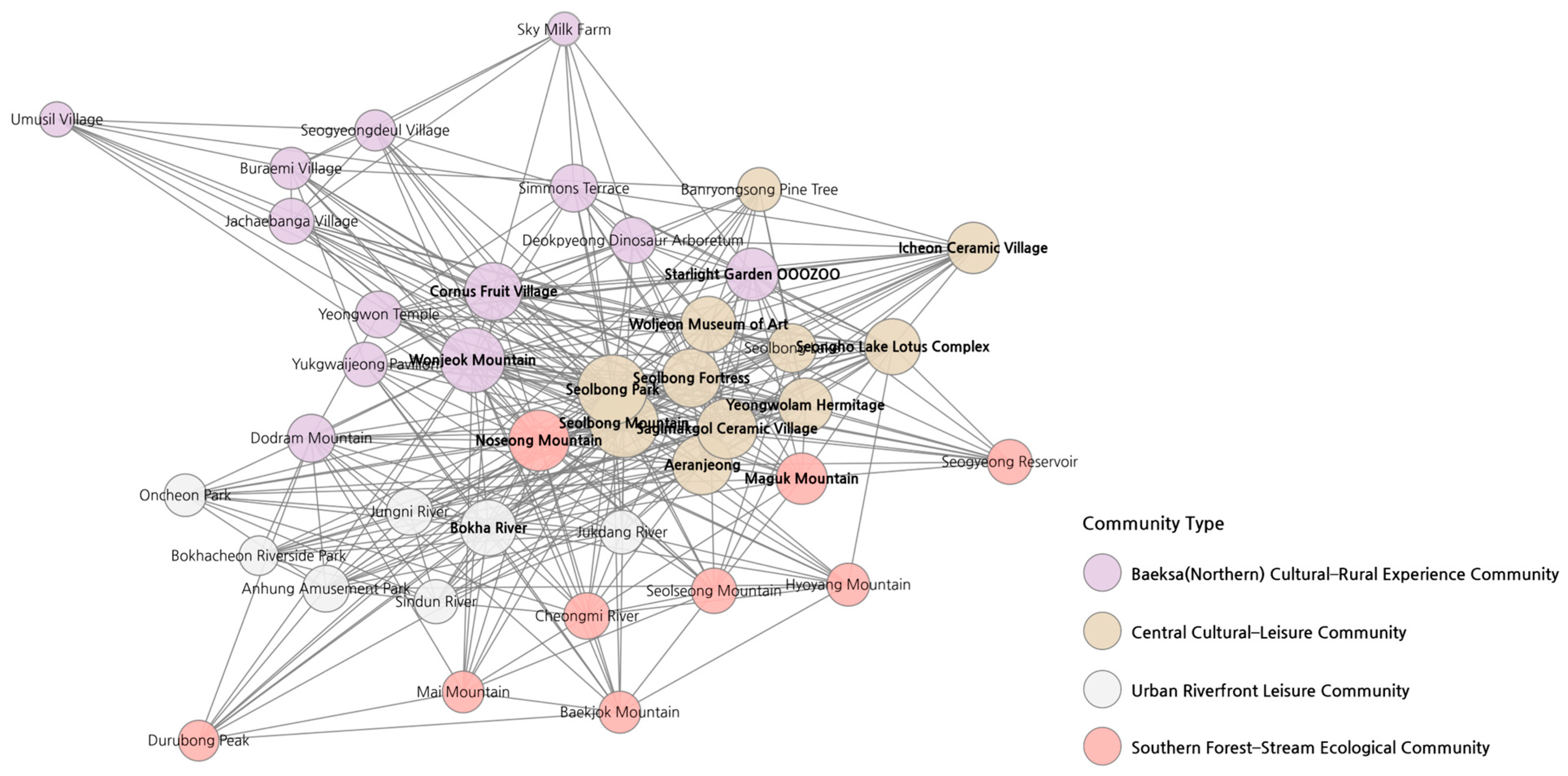User Perceptions of Text Mining in Peri-Rural Landscapes and Topic Modeling of Icheon City in the Seoul Metropolitan Region
Abstract
1. Introduction
- (1)
- Which natural landscape resources in peri-rural sites emerge as structurally central within user-generated narratives, and how can these be interpreted as indicators of cognitive influence?
- (2)
- What thematic communities and clusters of perceived value are revealed through the integration of network centrality and topic modeling?
- (3)
- How do these perceptual and thematic structures correspond to the spatial hierarchy and connectivity of peri-rural resource spaces? How can this correspondence be interpreted within the broader discourse on rural–urban linkages?
2. Literature Review
3. Materials and Methods
3.1. Study Area
3.2. Study Flow
- Step 1. Text Data Collection and Preprocessing
- Step 2. Development of a User Dictionary for Natural Landscape Resources in Icheon
- Step 3. Centrality Analysis of Natural Landscape Resources
- Step 4. LDA Topic Modeling Analysis
- Step 5. Integration and Interpretation
4. Results
4.1. Development of a Natural Landscape Resource Dictionary
4.2. Centrality Analysis of Natural Landscape Resources
4.3. Structural and Spatial Patterns of Natural Landscape Resources
- (a)
- Structural Patterns of Natural Landscape Resources
- (b)
- Spatial Pattern Based on Centrality
4.4. Thematic Structures of User Narratives on Peri-Rural Landscapes
4.5. Integration: Mapping Assets to Topics
5. Discussion
6. Conclusions
Author Contributions
Funding
Institutional Review Board Statement
Data Availability Statement
Conflicts of Interest
| 1 | Text cleaning was performed using the ‘replace’ function, which applied the user dictionary to standardize and refine the text. The Okt (Open Korean Text) morphological analyzer was then used to perform POS tagging, with nouns being extracted for further analysis due to their high semantic value in identifying topics and locations. |
| 2 | For readability, the communities identified through network analysis are hereafter described as ‘clusters’ to emphasize their spatial and thematic cohesion. |
References
- Simon, D. Urban environments: Issues on the peri-urban fringe. Annu. Rev. Environ. Resour. 2008, 33, 167–185. [Google Scholar] [CrossRef]
- Fagerholm, N.; Torralba, M.; Moreno, G.; Girardello, M.; Herzog, F.; Aviron, S.; Burgess, P.; Crous-Duran, J.; Ferreiro-Domínguez, N.; Graves, A.; et al. Cross-site analysis of perceived ecosystem service benefits in multifunctional landscapes. Glob. Environ. Chang. 2019, 56, 101948. [Google Scholar] [CrossRef]
- Nevzati, F.; Veldi, M.; Külvik, M.; Bell, S. Analysis of landscape character assessment and cultural ecosystem services evaluation frameworks for peri-urban landscape planning: A case study of Harku Municipality, Estonia. Land 2023, 12, 1825. [Google Scholar] [CrossRef]
- Sylla, M.; Solecka, I. Highly valued agricultural landscapes and their ecosystem services in the urban–rural fringe: An integrated approach. J. Environ. Plan. Manag. 2019, 63, 883–911. [Google Scholar] [CrossRef]
- Mulya, S.P.; Putro, H.P.H.; Hudalah, D. Review of peri-urban agriculture as a regional ecosystem service. Geogr. Sustain. 2023, 4, 233–245. [Google Scholar] [CrossRef]
- Chen, S.; Chen, H.; Yang, R.; Ye, Y. Linking social-ecological management and ecosystem service bundles: Lessons from a peri-urban agriculture landscape. Land Use Policy 2023, 132, 106697. [Google Scholar] [CrossRef]
- Navara, A.; Vedamuthu, R. Ecosystem services-based approach to sustainable development in a peri-urban area of Chennai, India. Environ. Dev. Sustain. 2021, 24, 2887–2913. [Google Scholar] [CrossRef]
- Kwak, S.-J.; Yoo, S.-H.; Han, S.-Y. Estimating the public’s value for urban forest in the Seoul Metropolitan Area of Korea: A contingent valuation study. Urban Stud. 2003, 40, 2207–2221, (In Korean with English abstract). [Google Scholar] [CrossRef]
- Im, H.-B.; Lee, S.-U. Measuring Economic Value of the Landscape of Rural Society. J. Korean Reg. Dev. Assoc. 2004, 16, 25–48. Available online: https://www.kci.go.kr/kciportal/ci/sereArticleSearch/ciSereArtiView.kci?sereArticleSearchBean.artiId=ART001134831 (accessed on 27 May 2025). (In Korean with English Abstract).
- Lee, C.H. Understanding rural landscape for better resident-led management: Residents’ perceptions on rural landscape as everyday landscapes. Land Use Policy 2020, 94, 104565. [Google Scholar] [CrossRef]
- Madaleno, I.M.; Gurovich, A. “Urban versus rural” no longer matches reality: An early public agro-residential development in periurban Santiago, Chile. Cities 2004, 21, 513–526. [Google Scholar] [CrossRef]
- OECD. OECD Regional Outlook 2016: Productive Regions for Inclusive Societies; OECD: Paris, France, 2016. [Google Scholar]
- Lei, J.; Xie, Y.; Chen, Y.; Zhong, T.; Lin, Y.; Wang, M. The transformation of peri-urban agriculture and its implications for urban–rural integration under the influence of digital technology. Land 2025, 14, 375. [Google Scholar] [CrossRef]
- Lerner, A.M.; Eakin, H. An obsolete dichotomy? Rethinking the rural–urban interface in terms of food security and production in the Global South. Geogr. J. 2011, 177, 311–320. [Google Scholar] [CrossRef]
- Mortoja, G.; Yigitcanlar, T.; Mayere, S. What is the most suitable methodological approach to demarcate peri-urban areas? A systematic review of the literature. Land Use Policy 2020, 95, 104601. [Google Scholar] [CrossRef]
- Sahana, M.; Ravetz, J.; Patel, P.P.; Dadashpoor, H.; Follmann, A. Where is the peri-urban? A systematic review of peri-urban research and approaches for its identification and demarcation worldwide. Remote Sens. 2023, 15, 1316. [Google Scholar] [CrossRef]
- Nilsson, K.; Pauleit, S.; Bell, S.; Aalbers, C.; Nielsen, T.S. (Eds.) Peri-Urban Futures: Scenarios and Models for Land Use Change in Europe; Springer: Berlin/Heidelberg, Germany, 2013; pp. 13–44. Available online: https://dlib.scu.ac.ir/bitstream/Hannan/320335/2/9783642305290.pdf (accessed on 18 June 2025).
- Cattivelli, V. The methods used to identify urban, rural, and intermediate territories at European level: A comparison of the methods developed in the framework of TERCET and ESPON. Cities 2023, 143, 104556. [Google Scholar] [CrossRef]
- Colucci, A. Peri-Urban/Peri-Rural Areas: Identities, Values and Strategies. In Peri-Urban Areas and Food-Energy-Water Nexus: Sustainability and Resilience Strategies in the Age of Climate Change; Springer International Publishing: Cham, Switzerland, 2016; pp. 99–104. Available online: https://link.springer.com/chapter/10.1007/978-3-319-41022-7_12 (accessed on 18 June 2025).
- Karlsson, C.; Olsson, M. The identification of functional regions: Theory, methods, and applications. Ann. Reg. Sci. 2006, 40, 1–18. [Google Scholar] [CrossRef]
- Klapka, P.; Halás, M. Conceptualising patterns of spatial flows: Five decades of advances in the definitionand use of functional regions. Morav. Geogr. Rep. 2016, 24, 2–11. [Google Scholar] [CrossRef]
- Kim, H.; Chun, Y.; Kim, K. Delimitation of Functional Regions Using a p-Regions Problem Approach. Int. Reg. Sci. Rev. 2015, 38, 235–263. [Google Scholar] [CrossRef]
- Gao, S.; Janowicz, K.; Couclelis, H. Extracting urban functional regions from points of interest and humanactivities on location-based social networks. Trans. GIS 2017, 21, 446–467. [Google Scholar] [CrossRef]
- Hall, P.G.; Pain, K. (Eds.) The Polycentric Metropolis: Learning from Mega-City Regions in Europe; Routledge: London, UK, 2016. [Google Scholar]
- OECD. Rural-Urban Partnerships: An Integrated Approach to Economic Development; OECD Publishing: Paris, France, 2013. [Google Scholar] [CrossRef]
- Dijkstra, L.; Poelman, H.; Veneri, P. The EU-OECD Definition of a Functional Urban Area; OECD Regional Development Working Papers, No. 2019/11; OECD Publishing: Paris, France, 2019; Available online: https://www.oecd.org/en/publications/the-eu-oecd-definition-of-a-functional-urban-area_d58cb34d-en.html (accessed on 4 May 2025).
- Fioretti, C.; Pertoldi, M. Exploring the functional area approach in EU urban strategies. Trans. Assoc. Eur. Sch. Plan. 2020, 4, 146–162. [Google Scholar] [CrossRef]
- Ubilla-Bravo, G.F. A Geospatial Model of Periurbanization—The Case of Three Intermediate-Sized and Subregional Cities in Chile. Land 2024, 13, 694. [Google Scholar] [CrossRef]
- Dekolo, S.; Ekum, M.I.; James, O.K.; Aigbavboa, C.; Gumbo, T. Safeguarding rural–urban linkages: Modeling drivers of peri-urban sprawl and impacts on ecosystem services. Front. Sustain. Cities 2025, 7, 1535619. [Google Scholar] [CrossRef]
- Drobne, S. Functional regions and areas: Literature review according to application fields. Géod. Vestn. 2017, 61, 35–57. [Google Scholar] [CrossRef]
- Soja, E.W. Regional Urbanization and the End of the Metropolis Era. In Cities in the 21st Century; Routledge: London, UK, 2016; pp. 41–59. Available online: https://www.taylorfrancis.com/chapters/edit/10.4324/9781315652221-9/regional-urbanization-end-metropolis-era-edward-soja (accessed on 8 August 2025).
- Zhu, Y.-G.; Reid, B.J.; Meharg, A.A.; Banwart, S.A.; Fu, B. Optimizing peri-urban ecosystems (PURE) to re-couple urban–rural symbiosis. Sci. Total Environ. 2017, 586, 1085–1090. [Google Scholar] [CrossRef]
- Yang, H.; Wu, R.; Qiu, B.; Zhang, Z.; Hu, T.; Zou, J.; Wang, H. The next step in suburban rural revitalization: Integrated whole-process landscape management linking ecosystem services and landscape characteristics. Ecol. Indic. 2024, 162, 111999. [Google Scholar] [CrossRef]
- Likitswat, F.; Sahavacharin, A. Landscape change analysis: Ecosystem services in the peri-urban agriculture of Bangkok. J. Arch. Res. Stud. 2022, 20, 25–38. [Google Scholar] [CrossRef]
- Komossa, F.; Wartmann, F.M.; Kienast, F.; Verburg, P.H. Comparing outdoor recreation preferences in peri-urban landscapes using different data gathering methods. Landsc. Urban Plan. 2020, 199, 103796. [Google Scholar] [CrossRef]
- Oteros-Rozas, E.; Martín-López, B.; Fagerholm, N.; Bieling, C.; Plieninger, T. Using social media photos to explore the relation between cultural ecosystem services and landscape features across five European sites. Ecol. Indic. 2018, 94, 74–86. [Google Scholar] [CrossRef]
- van Zanten, B.T.; Van Berkel, D.B.; Meentemeyer, R.K.; Smith, J.W.; Tieskens, K.F.; Verburg, P.H. Continental-scale quantification of landscape values using social media data. Proc. Natl. Acad. Sci. USA 2016, 113, 12974–12979. [Google Scholar] [CrossRef]
- Wartmann, F.M.; Acheson, E.; Purves, R.S. Describing and comparing landscapes using tags, texts, and free lists: An interdisciplinary approach. Int. J. Geogr. Inf. Sci. 2018, 32, 1572–1592. [Google Scholar] [CrossRef]
- OECD. OECD Regions and Cities at a Glance 2020; OECD Publishing: Paris, France, 2020. [Google Scholar]
- Garcilazo, E.; Martins, J.O. The Contribution of Regions to Aggregate Growth in the OECD. Econ. Geogr. 2015, 91, 205–221. Available online: https://www.tandfonline.com/doi/full/10.1111/ecge.12087?needAccess=true (accessed on 4 July 2025). [CrossRef]
- Hearst, M. What Is Text Mining; SIMS, University of California: Berkeley, CA, USA, 2003; Available online: https://www.jaist.ac.jp/~bao/MOT-Ishikawa/FurtherReadingNo1.pdf (accessed on 4 May 2024).
- Daniel, B. Big Data and analytics in higher education: Opportunities and challenges. Br. J. Educ. Technol. 2015, 46, 904–920. [Google Scholar] [CrossRef]
- Icheon City Government. 2030 Icheon Master Plan; Icheon City Government: Icheon, Republic of Korea, 2019. Available online: https://memory.library.kr/items/show/210052389 (accessed on 24 August 2024).
- Icheon City Government. 2020 Icheon Landscape Plan; Icheon City Government: Icheon, Republic of Korea, 2020. Available online: https://www.icheon.go.kr/depart/board/post/view.do?bcIdx=712&mid=0104030000&&idx=221751 (accessed on 24 August 2024).
- Icheon Urban-Rural Exchange Center (Icheon Nadri). (n.d.). Official Website. Available online: https://archives.icheon.go.kr/data01/static/3/1/www.2000green.com/index.html (accessed on 25 August 2024).
- Icheon Office of Education. Icheon Future Education Cooperation District. (n.d.). Ecological Education Map. Available online: https://oneclick.goeic.kr/contents/content.php?cIdx=11&fboard=board_ecomap (accessed on 25 August 2024).
- Cho, H. LDA-based Topic Modeling and Analysis on Batch Process Monitoring. J. Korea Acad. Coop. Soc. 2022, 23, 26–33. [Google Scholar] [CrossRef]
- Bishop, C.M.; Nasrabadi, N.M. Pattern Recognition and Machine Learning; Springer: New York, NY, USA, 2006; Volume 4, p. 738. Available online: https://link.springer.com/book/9781493938438 (accessed on 4 May 2025).
- Park, S.; Kang, J. Analysis of Prompt Engineering Methodologies and Research Status to Improve Inference Capability of ChatGPT and Other Large Language Models. J. Intell. Inf. Syst. 2023, 29, 287–308. [Google Scholar]
- Rosner, F.; Hinneburg, A.; Röder, M.; Nettling, M.; Both, A. Evaluating topic coherence measures. arXiv 2014, arXiv:1403.6397. [Google Scholar] [CrossRef]
- Rahimi, H.; Hoover, J.L.; Mimno, D.; Naacke, H.; Constantin, C.; Amann, B. Contextualized topic coherence metrics. arXiv 2023, arXiv:2305.14587. [Google Scholar] [CrossRef]






| Keyword | Raw Data Collected | First Filtering | Final Dataset |
|---|---|---|---|
| Ecology | 4342 | 4342 | 4342 |
| Natural Environment | 1317 | 1317 | 1317 |
| River | 669 | 669 | 669 |
| Green Space | 1611 | 1611 | 1611 |
| Urban Park | 2639 | 2639 | 2639 |
| Total | 10,578 | 10,094 | 8078 |
| Reference | Year | Dataset List |
|---|---|---|
| Icheon City Hall Website | 2019 | 2030 Icheon City Master Plan Icheon City Landscape Plan |
| Icheon City Landscape Plan | 2020 | Icheon City Landscape Plan |
| Icheon Nadeuri Website | 2024 | Experience Introductions (by theme, by education type, by target group) |
| Icheon Future Education Cooperation District Website | 2024 | Educational Ecology Map List |
| Threshold Type | Cutoff | Threshold Value | N Important | Overlap with ABS 0.15 | Jaccard Similarity |
|---|---|---|---|---|---|
| Absolute | 0.1 | – | 36 | 15 | 0.417 |
| Absolute | 0.15 | – | 18 | Baseline | Baseline |
| Absolute | 0.2 | – | 11 | 7 | 0.467 |
| Percentile | Top 20% | 0.127 | 21 | 8 | 0.533 |
| Percentile | Top 15% | 0.143 | 15 | 6 | 0.4 |
| Percentile | Top 10% | 0.167 | 9 | 4 | 0.267 |
| Number of Topics | Perplexity | Coherence Score |
|---|---|---|
| 2 | −8.17950 | 0.505029 |
| 3 | −8.03093 | 0.512123 |
| 4 | −7.86306 | 0.549874 |
| 5 | −7.85907 | 0.53245 |
| 6 | −7.85803 | 0.577521 |
| 7 | −7.81076 | 0.632482 |
| 8 | −7.72005 | 0.548551 |
| 9 | −7.65997 | 0.477363 |
| 10 | −7.68588 | 0.573926 |
| 11 | −7.65255 | 0.54421 |
| 12 | −7.63847 | 0.558604 |
| 13 | −7.62519 | 0.509085 |
| 14 | −7.64228 | 0.544934 |
| α (alpha) = 0.14, β (beta) = 0.14 | ||
| Division | Type | Item | Count |
|---|---|---|---|
| Natural Asset | Peaks and Rocks | Dodram Sambong (Three Peaks), Durubong Peak, Seolbong Mountain Yeongwolam, Malmeoribawi Rock, Cheondeokbong Peak | 5 |
| Mountain and Forests | Garae Mountain, Geonji Mountain, Noseong Mountain, Daedeok Mountain, Daemyeong Mountain, Dodram Mountain, Dolbakji Mountain, Maguk Mountain, Mao Mountain, Mai Mountain, Myoryong Mountain, Baekjok Mountain, Bongui Mountain, Seolbong Mountain, Seolseong Mountain, Sohak Mountain, Seungmyeong Mountain, Yanggak Mountain, Yeondae Mountain, Wonjeok Mountain, Imo Mountain, Palseong Mountain, Haeryong Mountain, Hyoyang Mountain, Wonjeok Mountain Dullegil Trail | 25 | |
| Reservoirs and Lakes | Godam Reservoir, Gocheok Reservoir, Daegwanri Reservoir, Sanyang Reservoir, Seogyeong Reservoir, Seongho Lake Lotus Complex, Aeranjeong, Yongmyeon Reservoir, Yongpung Reservoir, Wondu Reservoir, Jinga Reservoir, Hak-am Reservoir, Seoksan Reservoir, Anhung Amusement Park, Seolbong Lake | 15 | |
| Plains and Farmlands | Fields of the Prince, Prime Farmland | 2 | |
| Rivers and Streams | Geumsan River, Narae River, Choji River, Dongsan River, Dumi Stream, Maegok River, Bangchu River, Baekjok River, Bokha River, Seokwon River, Seolseong River, Songgok River, Songmal River, Sindae River, Sindun River, Yanghwa River, Wahyeon River, Wondu River, Yulhyeon River, Iji River, Jangneung River, Jangam River, Jeyo River, Jukdang River, Jungni River, Jinam River, Cheongmi River, Haeryong River, Haewul River | 29 | |
| Campsites | Eoreumbakgol Campsite | 1 | |
| Parks | 48th Children’s Park, Galsan 1st Park, Galsan 2nd Park, Gaenari Park, Gwan-go 6th Park, Dream Tree Park, Namcheon Park, Noseongsan Citizen’s Park, Agricultural and Rural Theme Park, Dalmaji Park, Dongsamaeul Park, Majang Neighborhood Park, Majunteo Park, Muchon Park, Bokhacheon Riverside Park, Buak Urban Natural Park, Buksamaeul Park, Saetbyeol Park, Seolbong Urban Natural Park, Seolbong Park, Songjeong Park, Songjeong 2nd Children’s Park, Symphony Park, Oncheon Park, Lee Su-heung Park, Jangnok Park, Rose Park, Janghowon Park, Jeungpo 3rd District 1st Children’s Park, Jeungpo 3rd District 2nd Children’s Park, Jeungpo 1st Park, Jeungpo 2nd Park, Jeungpo 3rd Park, Jinam Park, Cheongsong Park, Taeguk Park, Prugio Park, Hanmaeum Park, Hanareum Park, Haeryong Urban Natural Park, Hyanggyo Park, Hobok Leisure Sports Park, Hyoyang Park, Humansia Park, Hope Park, Baeksa Living Sports Park, Moga Living Sports Park, Sindun Township Sports Park | 48 | |
| Cultural/Artificial Asset | Other Complex Cultural Facilities | Icheon Ceramic Village, Sagimakgol Ceramic Village, Simmons Terrace, Buddhist Culture Complex | 4 |
| Golf Clubs | BA Vista Golf Club, The Crosby Golf Club, Jisan Golf Club | 3 | |
| Tourist Facilities | Dodram Theme Park, Miranda Hot Springs, Starlight Garden OOOZOOO, Termeden Hot Springs, Jisan Resort | 5 | |
| Tourist Attractions | Deokpyeong Dinosaur Arboretum, (Piattil) Pig Museum, Woljeon Museum of Art | 3 | |
| Rural Experience Amenities | Gilgyeong Farm, Nam Hyein Natural Dyeing, Daebeol Experience Center, Doniul Village, Doldaei Stone Village, Buraemi Village, Beatles Nature School, Sannaedeul Farm, Cornus Fruit Village, Seogyeongdeul Village, Sky Milk Farm, Umusil Village, Woongjin Children’s Village, Jachaebanga Village, Jangam Tourist Farm, Cheongam Tourist Farm, Pungwon Farm, Nature Country, Icheon Tourist Farm | 19 | |
| Cultural Heritage (Natural Landscape-Related) | Yukgwaijeong Pavilion, Prince Yangnyeong’s Historical Site, General Eo Jae-yeon’s Birthplace, Banryongsong (tree), Icheon White Pine (tree), Yeongwon Temple, Wonjeok Temple, Yeongwolam Stone Buddha and Lotus Pedestal, Seolbong Fortress, Seolseongsan Seolseong Site, Icheon Confucian School | 11 | |
| Total | 170 | ||
| Keyword | Degree Centrality * | Betweenness Centrality ** | Eigenvector Centrality *** | |
|---|---|---|---|---|
| 1 | Seolbong Urban Park | 0.6559 | 0.2828 | 0.3033 |
| 2 | Seolbong Mountain | 0.5161 | 0.0936 | 0.2780 |
| 3 | Bokha River | 0.4194 | 0.1267 | 0.1955 |
| 4 | Noseong Mountain | 0.3978 | 0.0811 | 0.2184 |
| 5 | Cornus Fruit Village | 0.3871 | 0.0505 | 0.2065 |
| 6 | Wonjeok Mountain | 0.3763 | 0.0350 | 0.2343 |
| 7 | Cheongmi River | 0.2903 | 0.0700 | 0.1346 |
| 8 | Aeranjeong Pavilion | 0.2903 | 0.0089 | 0.1947 |
| 9 | Sagimakgol Ceramic Village | 0.2796 | 0.0127 | 0.1922 |
| 10 | Maguk Mountain | 0.2688 | 0.0439 | 0.1541 |
| 11 | Seolseong Mountain | 0.2688 | 0.0518 | 0.1293 |
| 12 | Seolbong Fortress | 0.2688 | 0.0135 | 0.1836 |
| 13 | Anhung Amusement Park | 0.2473 | 0.0157 | 0.1366 |
| 14 | Woljeon Museum of Art | 0.2258 | 0.0064 | 0.1648 |
| 15 | Seongho Lake Lotus Complex | 0.2258 | 0.0080 | 0.1675 |
| 16 | Yeongwolam Hermitage | 0.2151 | 0.0054 | 0.1571 |
| 17 | Jachaebanga Village | 0.2151 | 0.0091 | 0.1306 |
| 18 | Buraemi Village | 0.2043 | 0.0269 | 0.1142 |
| 19 | Starlight Garden OOOZOO | 0.2043 | 0.0033 | 0.1482 |
| 20 | Seogyeongdeul Village | 0.1935 | 0.0081 | 0.1110 |
| 21 | Dodram Mountain | 0.1935 | 0.0055 | 0.1295 |
| 22 | Simmons Terrace | 0.1935 | 0.0062 | 0.1274 |
| 23 | Jungni River | 0.1935 | 0.0101 | 0.1188 |
| 24 | Deokpyeong Dinosaur Arboretum | 0.1828 | 0.0252 | 0.1191 |
| 25 | Sindun River | 0.1828 | 0.0152 | 0.1093 |
| 26 | Baekjok Mountain | 0.1828 | 0.0175 | 0.1040 |
| 27 | Hyoyang Mountain | 0.1720 | 0.0087 | 0.1098 |
| 28 | Icheon Ceramic Village | 0.1720 | 0.0010 | 0.1374 |
| 29 | Seolbong Lake | 0.1720 | 0.0054 | 0.1280 |
| 30 | Mai Mountain | 0.1613 | 0.0118 | 0.1023 |
| 31 | Oncheon Park | 0.1613 | 0.0090 | 0.1063 |
| 32 | Yukgwaijeong Pavilion | 0.1613 | 0.0087 | 0.1109 |
| 33 | Jukdang River | 0.1505 | 0.0031 | 0.1065 |
| 34 | Sky Milk Farm | 0.1505 | 0.0063 | 0.0752 |
| 35 | Yeongwon Temple | 0.1505 | 0.0011 | 0.1164 |
| 36 | Pig Museum (Piattil) | 0.1398 | 0.0012 | 0.0711 |
| 37 | Bokhacheon Riverside Park | 0.1398 | 0.0022 | 0.0902 |
| 38 | Seogyeong Reservoir | 0.1290 | 0.0067 | 0.1043 |
| 39 | Durubong Peak | 0.1290 | 0.0012 | 0.0960 |
| 40 | Banryongsong Pine Tree | 0.1290 | 0.0009 | 0.1024 |
| Topic | Label | Top 20 Keywords | Number of Documents | Share (%) |
|---|---|---|---|---|
| 1 | Suburbanization and real estate transactions | auction, land, real estate, region, Seolbong Mountain, sale, bid, planning, facility, logistics warehouse, factory, development, building, rural housing, management, site, apartment, road, district, property, investment | 699 | 17.16 |
| 2 | Rural residential life and housing management | cleaning, demolition, site, construction, treatment, replacement, cost, installation, specialist, Seolbong Mountain, repair, flooring, construction work, plumbing, maintenance, removal, safety, visit, solution, equipment | 465 | 11.42 |
| 3 | Real estate promotion emphasizing natural accessibility | housing complex, apartment, sales, facility, Seolbong Mountain, Lotte, lifestyle, project, park, housing, installation, environment, Castle, district, region, subscription, type, development, Sky, kitchen | 600 | 14.73 |
| 4 | Metropolitan-scale housing development projects | Raeb(apartment), Songjeong-dong, sales, housing complex, apartment, facility, environment, park, education, Seolbong Mountain, Icheon Xi The Raeb apartment, golf, transportation, region, model house, residents, subscription, household, housing, convenience | 369 | 9.06 |
| 5 | Seasonal leisure and sports activities | ski, ski resort, Cornus fruit, resort, visit, food, rice, meal, equipment, lesson, ceramics, hot pot, hall, side dish, Jangheung, management, chicken soup, rental, cooking, parking lot | 437 | 10.73 |
| 6 | Family tourism and culinary experiences | child, meat, pig, experience, visit, museum, course, photo, Simmons Terrace, parking, Pig Museum, dinosaur, meal, travel, hot spring, animal, shop, weekend, family, indoor | 842 | 20.67 |
| 7 | Cultural festivals and environmental improvement projects | festival, village, park, culture, experience, Seolbong Mountain, Seolbong Park, event, nature, region, library, ceramics, operation, art, program, activity, tradition, stream, project, history | 661 | 16.23 |
| Total | 4073 | 100% |
| Topic | LDA Topics Label | Overlapping Keywords with Central Assets | Corresponding Cluster (Community Detection) |
|---|---|---|---|
| 1 | Real estate transactions related to suburbanization | Seolbong Mountain | Central Cultural–Leisure Cluster |
| 2 | Suburban residential life and housing management/construction | Seolbong Mountain | Central Cultural–Leisure Cluster |
| 3 | Real estate promotion emphasizing natural accessibility | Seolbong Mountain, Seolbong Park | Central Cultural–Leisure Cluster |
| 4 | Metropolitan-scale housing development projects | Seolbong Mountain | Central Cultural–Leisure Cluster |
| 5 | Seasonal leisure and recreational activities | Cornus fruit (Sansuyu), Ceramics | Southern Forest–Stream Ecological Cluster & Baeksa (Northern) Cultural–Rural Experience Cluster |
| 6 | Family tourism and culinary experiences | Simmons Terrace, PiaTtil Pig Museum, Dinosaur (linked to Dinosaur Arboretum), Museum | Central Cultural–Leisure Cluster |
| 7 | Community-led cultural festivals and environmental improvement projects | Seolbong Mountain, Seolbong Park, Ceramics | Baeksa (Northern) Cultural–Rural Experience Cluster & Central Cultural–Leisure Cluster |
Disclaimer/Publisher’s Note: The statements, opinions and data contained in all publications are solely those of the individual author(s) and contributor(s) and not of MDPI and/or the editor(s). MDPI and/or the editor(s) disclaim responsibility for any injury to people or property resulting from any ideas, methods, instructions or products referred to in the content. |
© 2025 by the authors. Licensee MDPI, Basel, Switzerland. This article is an open access article distributed under the terms and conditions of the Creative Commons Attribution (CC BY) license (https://creativecommons.org/licenses/by/4.0/).
Share and Cite
Kim, D.; Park, J.; Son, Y. User Perceptions of Text Mining in Peri-Rural Landscapes and Topic Modeling of Icheon City in the Seoul Metropolitan Region. Land 2025, 14, 1927. https://doi.org/10.3390/land14091927
Kim D, Park J, Son Y. User Perceptions of Text Mining in Peri-Rural Landscapes and Topic Modeling of Icheon City in the Seoul Metropolitan Region. Land. 2025; 14(9):1927. https://doi.org/10.3390/land14091927
Chicago/Turabian StyleKim, Doeun, Junho Park, and Yonghoon Son. 2025. "User Perceptions of Text Mining in Peri-Rural Landscapes and Topic Modeling of Icheon City in the Seoul Metropolitan Region" Land 14, no. 9: 1927. https://doi.org/10.3390/land14091927
APA StyleKim, D., Park, J., & Son, Y. (2025). User Perceptions of Text Mining in Peri-Rural Landscapes and Topic Modeling of Icheon City in the Seoul Metropolitan Region. Land, 14(9), 1927. https://doi.org/10.3390/land14091927







